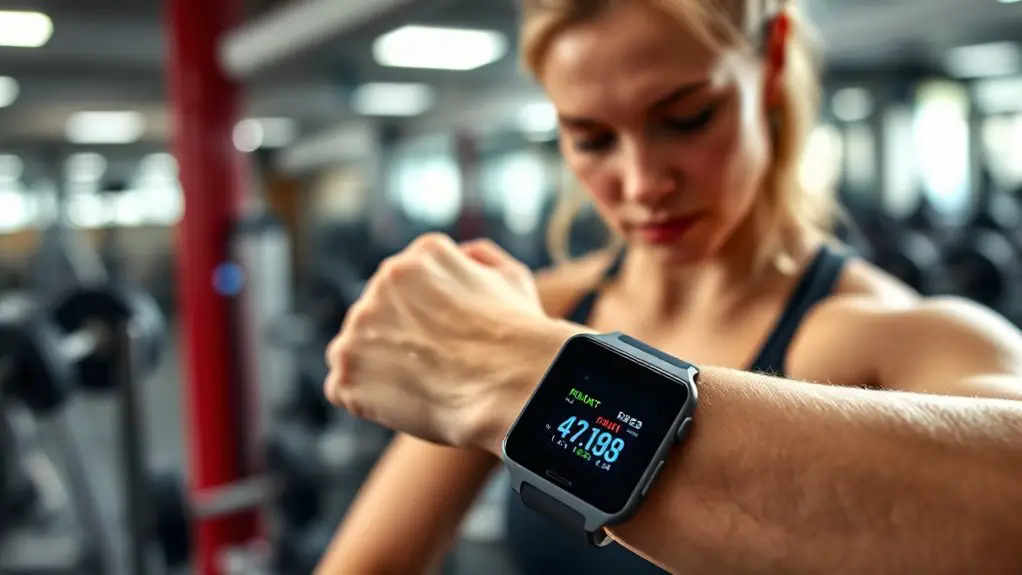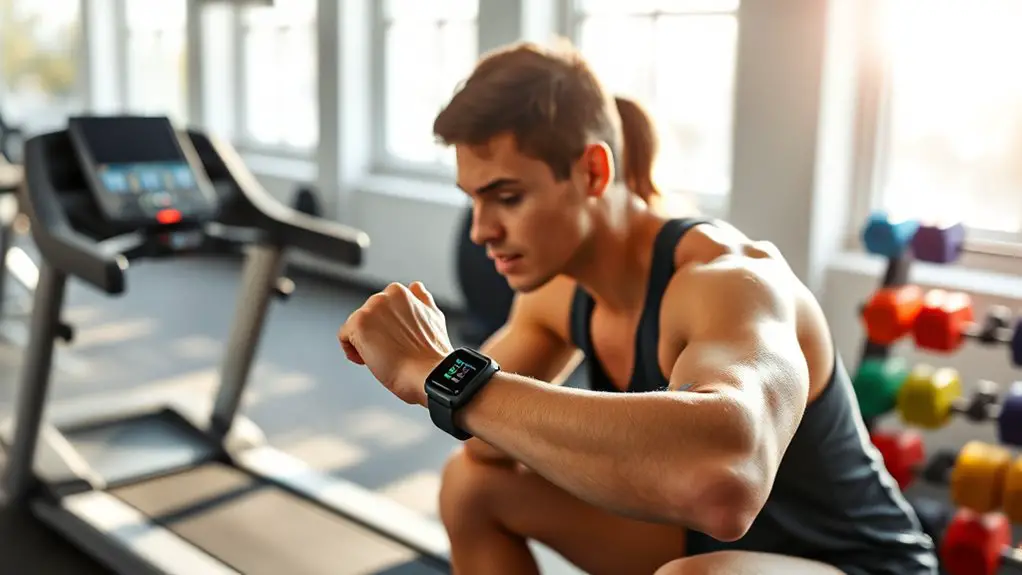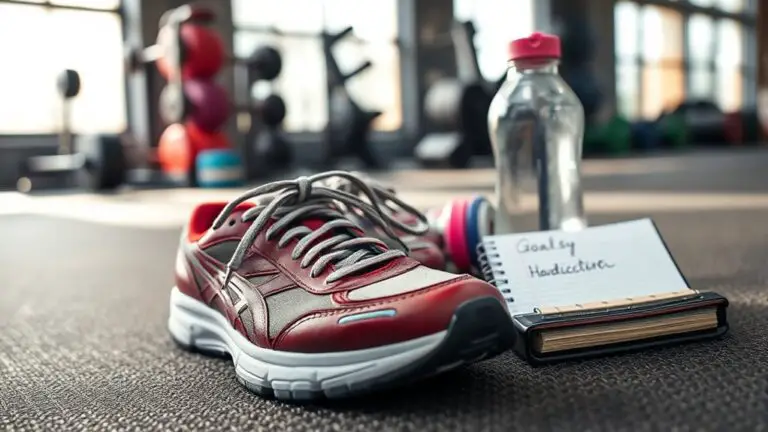The Benefits of Using a Heart Rate Monitor During Gym Training

Using a heart rate monitor during gym training offers several key benefits. It helps you stay within target heart rate zones for ideal intensity, boosting your caloric burn. You’ll track your progress in real-time, enhancing motivation and accountability. The monitor also aids in injury prevention by recognizing signs of overtraining, ensuring you don’t push too hard. Plus, it personalizes your workouts to align with your fitness goals. Let’s explore how this tool can elevate your training experience even further.
Understanding Your Heart Rate Zones

Understanding your heart rate zones is vital for maximizing your workouts and achieving your fitness goals. By familiarizing yourself with these zones, you can tailor your training to enhance heart rate variability, which is essential for overall cardiovascular health. Zone training helps you identify the intensity level at which you should exercise to burn fat, build endurance, or improve performance.
When you monitor your heart rate, you can effectively track your progress and guarantee you’re working within the ideal zones. For example, the fat-burning zone is typically 60-70% of your maximum heart rate, while the aerobic zone ranges from 70-80%. By staying in these zones, you can boost your efficiency and get the most out of each session. So, don’t overlook the importance of understanding your heart rate zones; they’re key to releasing your full potential and staying motivated on your fitness journey.
Enhanced Workout Efficiency
When you track your heart rate during workouts, you’re not just monitoring numbers; you’re enhancing your performance. By maintaining awareness of your heart rate, you can improve workout efficiency, ensuring you’re getting the most out of every session. Here’s how:
- Target Specific Heart Rate Zones: Tailor your workouts to achieve peak fitness intensity.
- Maximize Caloric Burn: Increase your calorie expenditure by pushing yourself into higher intensity zones.
- Prevent Overtraining: Avoid fatigue by recognizing when your heart rate exceeds safe limits.
- Track Progress: See improvements in your fitness levels as your heart rate adjusts over time.
- Customize Workouts: Adjust your training based on real-time feedback for better results.
Using a heart rate monitor empowers you to fine-tune your regimen, making each workout more effective. By focusing on your heart rate, you’re not just working harder; you’re working smarter.
Motivation and Accountability

A heart rate monitor can greatly boost your motivation and accountability during workouts. By tracking your heart rate, you can set achievable goals and monitor your progress in real-time. This makes it easier to stay committed and push through tough sessions. If you’re working out with a partner, sharing your heart rate data can enhance your workout partnership, keeping both of you accountable.
| Goal | Current Heart Rate | Action Needed |
|---|---|---|
| Fat Burn | 120 bpm | Maintain pace |
| Cardio Endurance | 150 bpm | Increase intensity |
| Peak Performance | 180 bpm | Push harder |
With a heart rate monitor, you’re not just guessing your intensity; you’re making informed decisions. This clarity can transform your workout experience, ensuring you stay motivated and on track to achieve your fitness goals.
Injury Prevention and Recovery
Using a heart rate monitor can be a game changer for preventing injuries and enhancing your recovery. By keeping an eye on your heart rate, you can avoid overexertion and tailor your workouts to match your body’s needs. Plus, it helps you develop effective recovery strategies to bounce back quicker and train smarter.
Monitoring Overexertion Levels
While you’re pushing your limits during workouts, monitoring overexertion levels is essential for injury prevention and recovery. Ignoring signs of overtraining can lead to setbacks that hinder your progress. A heart rate monitor helps you track your heart rate variability, ensuring you stay within safe limits. Here’s why it matters:
- Identifies overtraining signs early
- Prevents injuries from excessive strain
- Supports ideal training intensity
- Aids in recognizing when to rest
- Enhances overall workout effectiveness
Enhancing Recovery Strategies
To enhance your recovery strategies, incorporating a heart rate monitor can make a significant difference in how effectively you bounce back from workouts. By tracking your heart rate during rest intervals, you can guarantee you’re not overexerting yourself and allow your body to recover efficiently. Utilizing a heart rate monitor helps you identify the ideal intensity for active recovery sessions, promoting circulation and reducing muscle soreness. This insight can guide you in scheduling your workouts to include adequate rest periods, ultimately preventing injuries. The more aware you are of your body’s signals, the better equipped you’ll be to tailor your recovery strategies. So, invest in a heart rate monitor and watch your recovery improve, leading to enhanced performance in the gym.
Tailoring Your Fitness Goals

When you set out to achieve your fitness goals, having a heart rate monitor can greatly enhance your approach. It allows you to tailor your workouts based on real-time data, ensuring you’re on track with your goal setting. By incorporating a fitness assessment, you can establish a baseline and make adjustments as needed.
Here are some ways a heart rate monitor can help you tailor your fitness goals:
- Identify your target heart rate zone for ideal training.
- Adjust workout intensity based on your heart rate feedback.
- Track your progress in reaching your fitness benchmarks.
- Personalize your training to align with specific goals, like weight loss or endurance.
- Stay motivated by visualizing your performance data.
Tracking Progress Over Time
As you work toward your fitness goals, tracking your progress over time becomes increasingly important. One effective way to do this is by monitoring your heart rate variability (HRV). HRV reflects your body’s readiness to perform and recover, giving you insight into how well you’re adapting to your training regimen. By consistently recording your heart rate during workouts, you can identify patterns and make informed adjustments to your routine.
Celebrating fitness milestones becomes more meaningful when you can see your improvements over time. Whether you’re increasing your endurance or lifting heavier weights, tracking your heart rate helps you understand your progress. When you notice changes in your HRV, it can motivate you to push further or take needed rest days. Ultimately, using a heart rate monitor not only helps you achieve your goals but also enhances your overall fitness journey, keeping you engaged and focused.
Integrating Technology Into Your Routine

Integrating technology into your fitness routine can greatly enhance your training experience and outcomes. By utilizing wearable devices and fitness apps, you can refine your workouts and achieve your goals more effectively. Here are some ways to seamlessly incorporate technology into your regimen:
- Track your heart rate in real-time to confirm you’re training in the ideal zone.
- Set fitness goals and monitor your progress through user-friendly fitness apps.
- Receive personalized workout plans based on your performance and preferences.
- Join virtual classes or challenges to stay motivated and engaged.
- Analyze your data to identify trends and adjust your training accordingly.
Frequently Asked Questions
Can Beginner Athletes Benefit From Using a Heart Rate Monitor?
Absolutely, beginner athletes can benefit from using a heart rate monitor. It provides beginner insights into your training effectiveness, helping you understand how hard you’re working. By tracking your heart rate, you can tailor your workouts to improve endurance and avoid overtraining. You’ll quickly learn to adjust your intensity levels, making your training sessions more productive. So, investing in a heart rate monitor can really enhance your journey as a beginner athlete!
How Do I Choose the Right Heart Rate Monitor for My Needs?
Choosing the right heart rate monitor for your needs involves a features comparison based on your workout goals. Consider options that track heart rate variability, calories burned, and sync with your smartphone. You’ll also want to look at the price range; there are budget-friendly models that still offer great functionality. Investing in a monitor that aligns with your fitness routine can enhance your training experience, making it worthwhile to explore your options carefully.
What Types of Exercises Are Best for Heart Rate Monitoring?
Imagine your heart as a drummer, keeping the beat of your workout. For heart rate monitoring, interval training and aerobic workouts are your best companions. Interval training sends your heart racing, alternating between high and low intensities, while aerobic workouts keep it steady and strong. These exercises not only elevate your heart rate but also enhance your endurance and overall fitness. By tracking your heart rate, you’ll fine-tune your sessions for maximum results.
Are Heart Rate Monitors Suitable for All Age Groups?
Yes, heart rate monitors are suitable for all age groups, but age considerations and fitness levels are key. Younger individuals might prefer more advanced features, while older adults may benefit from simpler models that focus on essential metrics. Regardless of age, everyone can use a heart rate monitor to track their fitness progress and guarantee they’re exercising safely. It’s a great way to stay motivated and reach your personal fitness goals effectively.
How Do I Maintain My Heart Rate Monitor for Accuracy?
Keeping your heart rate monitor in tip-top shape is like striking gold. To maintain accuracy, start with calibration techniques—follow the manufacturer’s instructions for adjustments based on your unique physiology. Regularly check the battery, replacing it as needed to avoid false readings. Wipe the sensors clean to prevent any interference. By giving a little attention here and there, you’ll guarantee your monitor’s reliable and ready to support your fitness journey.





